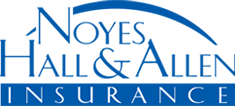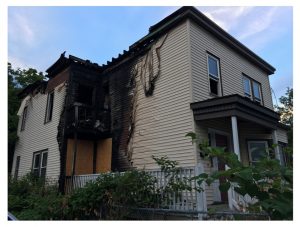 One year ago this weekend, my bedroom phone woke me at 7:00 on Saturday morning – never a good sign. It was my business partner, Tom. “The building’s on fire”, he said as sirens screamed in the background. I quickly dressed and raced to the office to find firefighters crawling all over our office building, battling smoke, water and flames.
One year ago this weekend, my bedroom phone woke me at 7:00 on Saturday morning – never a good sign. It was my business partner, Tom. “The building’s on fire”, he said as sirens screamed in the background. I quickly dressed and raced to the office to find firefighters crawling all over our office building, battling smoke, water and flames.
We’ve helped so many clients recover from disaster over the years. Now, it was our insurance agency’s turn to be the victim.
The fire wasn’t all that big. It started when the electric sign on the fascia of the building shorted. It burned through the overhang and spread up the roof, where it eventually burned through, setting off the sprinkler system. Three or four sprinkler heads opened, pouring water for about 40 minutes before the fire department shut it off. By 9:30 am, the fire was out and the cleanup and recovery began.
Six weeks later, everyone was back in the building, and 95% of the damage was repaired.
Lessons from an Office Fire
1. Safety Pays.
Even though we’re in the safety business, we’re not that different from anyone else. We curse the fact that we have to punch in our alarm codes when we open and close the office every day. We dread the quarterly visit from the sprinkler contractor, who tests the system, causing screeching alarms while we’re trying to work and meet with clients. We curse the calls from our alarm monitoring system when they call us at night or on the weekend to tell us they’re getting an alarm signal that’s almost always false. We don’t look forward to our annual fire department inspection.
 But on that Saturday morning, we were thankful that the alarm system alerted the Fire Department, that the sprinkler system doused most of the fire, and that the South Portland Fire Department responded so quickly and was so helpful in the beginning stages of our recovery. Without all of these safety systems, the fire would have been much bigger, and our recovery many times longer.
But on that Saturday morning, we were thankful that the alarm system alerted the Fire Department, that the sprinkler system doused most of the fire, and that the South Portland Fire Department responded so quickly and was so helpful in the beginning stages of our recovery. Without all of these safety systems, the fire would have been much bigger, and our recovery many times longer.
 2. Relationships are Important. We called ServPro, a remediation contractor that we knew from many fire, water and other disasters that our clients have experienced over the years. They extracted over an inch of water from the floor of our 9500 square foot building, and set up giant fans to begin the drying process.
2. Relationships are Important. We called ServPro, a remediation contractor that we knew from many fire, water and other disasters that our clients have experienced over the years. They extracted over an inch of water from the floor of our 9500 square foot building, and set up giant fans to begin the drying process.
We hired Maine Properties, another contractor that we knew from their work with many condo associations that we insure, to do the repair work. They were on the scene that day, scoping out what could be salvaged and what would need to be ripped out and replaced.
Our computer network consultant, Tom Vose of BroadSound Technologies, showed up Sunday to help us get our computer network up and running. Like most modern businesses, we’re almost completely dependent upon our computer system to help us serve our clients. The day before, we were picking computers up off the floor and dumping water out of them. We thought they were fried. Miraculously, every workstation but one survived.
As insurance agents, you would expect us to be well-insured, and we are. Of course, our insurance was with one of the companies we represent, Peerless Insurance. They were responsive, cooperative and professional in settling our claim.
Our other insurance company partners were empathetic, too. When they heard of our misfortune, they were quick to offer any accommodation to help us serve our mutual clients. Their response was heartwarming. Even one of our competitors, Dan Haley from Portland, called to offer the use of his office if we needed it.

3. Our team is our strength
Insurance is a people business, and we have some of the best. Many of them have worked with us for decades. They’re professionals who work well together and have our clients’ best interest at heart. We’ve always known how important our staff is to our success, but the fire really emphasized that. They showed up for work on Monday, ready to do whatever they needed to do in a smoky, wet, cold building. For weeks, they tolerated noise, dust, smell, balky equipment and physical upheaval. Perhaps the best testament to their professionalism is that most clients never even knew we had a fire. We prided ourselves that we didn’t miss a minute of regular office hours. Our staff was the key to our continuous operation.

4. Everything’s Bigger Than It Looks
From the outside, our fire looked minor. There were a couple of holes in the roof and a couple of more in the fascia, all of which were repaired within a few days. The fire damage was heavier in the side of the building occupied by Town & Country Credit Union and The HCR Group. But the water discharged from the sprinkler system spread throughout the building. We had to rip up all of the carpet, and cut much of the sheetrock several inches from the floor to allow drying. The cost to repair the damage from our “small” fire was hundreds of thousands of dollars. It took months for everything to get back to normal.
 5. Pay Attention to the Little StuffOur fire was caused by a short in an electrical sign on the front of the building. We had noticed a few days before that the lights behind a couple of letters were not lit. We assumed that they were burned out, and put it on our mental “to do list” to check out later. We never got the chance. We learned our lesson. Whenever something’s “not quite right”, we take action. You never know when a little issue can become a big one.
5. Pay Attention to the Little StuffOur fire was caused by a short in an electrical sign on the front of the building. We had noticed a few days before that the lights behind a couple of letters were not lit. We assumed that they were burned out, and put it on our mental “to do list” to check out later. We never got the chance. We learned our lesson. Whenever something’s “not quite right”, we take action. You never know when a little issue can become a big one.
6. Insurance Works
Having enough insurance allowed us to act quickly to repair all of the damage. We didn’t have to worry about how to pay for it all. It was the same for our tenants who had insurance. Those who were displaced were able to set up temporary offices in their homes. Their expenses, including phone, internet and other utilities, were covered by insurance. Those who didn’t have insurance were fortunate that they were able to move back in quickly, with little down time. If they had been in the more heavily damaged part of the building, they may not have been able to continue their businesses.
We hope that sharing these six lessons we learned helps you in your own disaster planning, whether for your business or your family. We also hope that you never have to pull such plans off the shelf and put them into action.
Of the 10 home and auto insurers we represent, 8 use “insurance scores” – a variation of a consumer credit score – as a rating factor. Another considers credit information when underwriting. Only 1 of the 10 does not consider credit information.


 Your Landlord’s Insurance Doesn’t Cover You
Your Landlord’s Insurance Doesn’t Cover You